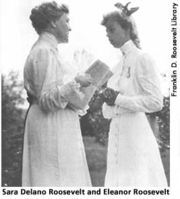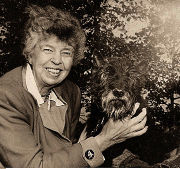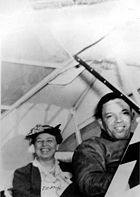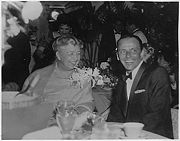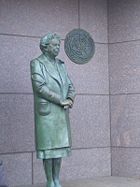Eleanor Roosevelt
2008/9 Schools Wikipedia Selection. Related subjects: Political People; Writers and critics
|
Eleanor Roosevelt
|
|
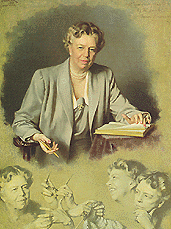 White House portrait |
|
|
|
|
| In office December 31, 1946 – December 31, 1952 |
|
| President | Harry S. Truman |
|---|---|
|
President and Chair of the United Nations Commission on Human Rights
|
|
| In office 1946 – 1952 |
|
| Preceded by | New Position |
| Succeeded by | Charles Malik |
|
Chair of the Presidential Commission on the Status of Women
|
|
| In office 1961 – 1962 |
|
| President | John F. Kennedy |
| Preceded by | New Office |
| Succeeded by | Commission work taken over by Esther Peterson after Commissioner Roosevelt's death |
|
First Lady of the United States
|
|
| In office March 4, 1933 – April 12, 1945 |
|
| Preceded by | Lou Henry Hoover |
| Succeeded by | Elizabeth "Bess" Wallace Truman |
|
|
|
| Born | October 11, 1884 New York, New York |
| Died | November 7, 1962 (aged 78) New York, New York |
| Political party | Democratic |
| Spouse | Franklin D. Roosevelt |
| Children | Anna Eleanor, James, Elliott, Franklin, John |
| Residence | Hyde Park, New York |
| Occupation | First Lady, diplomat, activist |
| Religion | Episcopal |
Anna Eleanor Roosevelt (IPA: /ˈɛlɪnɔr ˈroʊzəvɛlt/; October 11, 1884 – November 7, 1962) was First Lady of the United States from 1933 to 1945. She supported the New Deal policies of her husband, President Franklin D. Roosevelt, and assumed a role as an advocate for civil rights. After her husband's death in 1945, Roosevelt continued to be an internationally prominent author and speaker for the New Deal coalition. She worked to enhance the status of working women, although she opposed the Equal Rights Amendment because she believed it would adversely affect women.
In the 1940s, Roosevelt was one of the co-founders of Freedom House and supported the formation of the United Nations. Roosevelt founded the UN Association of the United States in 1943 to advance support for the formation of the UN. She was a delegate to the UN General Assembly from 1945 and 1952, a job for which she was appointed by President Harry S. Truman and confirmed by the United States Senate. During her time at the United Nations she chaired the committee that drafted and approved the Universal Declaration of Human Rights. President Truman called her the "First Lady of the World" in tribute to her human rights achievements.
Active in politics for the rest of her life, Roosevelt chaired the John F. Kennedy administration's ground-breaking committee which helped start second-wave feminism, the Presidential Commission on the Status of Women. She was one of the most admired persons of the 20th century, according to Gallup's List of Widely Admired People.
Personal life
Early life
Anna Eleanor Roosevelt was born on October 11, 1884, at 56 West 37th Street in New York City, New York. Her parents were Elliott Roosevelt and Anna Hall Roosevelt. She was named Anna for her mother and for her aunt, Anna Cowles and Eleanor for her father, who was nicknamed "Ellie". From the beginning, Roosevelt preferred to be called by her middle name, Eleanor. Two brothers, Elliott, Jr. (1889–1893) and Hall Roosevelt (1891–1941) were born later. She also had a half brother, Elliott Roosevelt Mann, the result of an extramarital relation between Elliot and Katy Mann, a young servant girl employed by Anna. Roosevelt was born into a world of immense wealth and privilege, as her family was part of New York high society called the "swells".
When Roosevelt was eight, her mother died of diphtheria and she and her brothers were sent to live with her maternal grandmother, Mary Ludlow Hall (1843–1919) at Tivoli, New York and at a brownstone in New York City. Just before Roosevelt turned ten, she was orphaned when her father died of complications of alcoholism. In his Pulitzer Prize-winning biography of Eleanor Roosevelt, author Joseph Lash describes her during this period of childhood as insecure and starved for affection, considering herself "ugly". In the fall of 1899, with the encouragement of her paternal aunt Bamie Cowles, the family decided to send Roosevelt to Allenswood Academy, an English finishing school. The headmistress, Marie Souvestre, was a noted feminist educator who sought to cultivate independent thinking in the young women in her charge. Roosevelt learned to speak French fluently and gained self-confidence. Her first-cousin Corinne Robinson, whose first term at Allenswood overlapped with Roosevelt's last, said that when she arrived at the school, Roosevelt was "everything".
Marriage and family life
In 1902 at age 17, Eleanor Roosevelt returned to the United States, ending her formal education, and was later given a debutante party. Soon afterward, she met her father's ( Elliott Roosevelt's) fifth cousin Franklin D. Roosevelt, then a 20-year-old junior at Harvard University. Following a White House reception and dinner with her uncle, President Theodore Roosevelt, on New Year's Day, 1903, Franklin's courtship of Eleanor began. In November, 1903, they became engaged, although the engagement was not announced for more than a year, until December 1, 1904, at the insistence of Franklin's mother, Sara Delano Roosevelt. Franklin Delano Roosevelt and Anna Eleanor Roosevelt were married on St. Patrick's Day (March 17, 1905) at Eleanor's great-aunt's home in New York City. The marriage produced six children, five of whom survived infancy: Anna Eleanor, Jr., James, Franklin Delano, Jr. (who was born and died in 1909), Elliott, Franklin Delano, and John Aspinwall. Following a honeymoon in Europe, the newlyweds settled in New York City, in a house provided by Sara, as well as at the family's estate overlooking the Hudson River in Hyde Park, New York.
The family began spending summers at Campobello Island, New Brunswick, on the Maine–Canada border, where Franklin was stricken with high fever in August, 1921, which resulted in permanent paralysis of his legs. Although the disease was widely believed during his lifetime to be poliomyelitis, some retrospective analysts now favour the diagnosis of Guillain-Barré syndrome (see Franklin D. Roosevelt's paralytic illness). Franklin's attending physician, Dr. William Keen, believed it was polio and commended Eleanor's devotion to the stricken Franklin during that time of travail, "You have been a rare wife and have borne your heavy burden most bravely", proclaiming her "one of my heroines". A play and movie depicting that time, Sunrise at Campobello, were produced almost 40 years later.
Relationship with mother-in-law
Roosevelt had a contentious relationship with her domineering mother-in-law, Sara Delano Roosevelt. Long before Eleanor fell in love with her future husband and distant cousin, Franklin, she already had a relationship with Sara as a distant but highly engaging cousin with whom she corresponded. Although they had a difficult relationship, Sara sincerely wanted to be a mother to Eleanor and did her best before and during the marriage to fill this role. Sara had her own reasons for attempting to prevent their marriage and historians continue to discuss them. Historians also have had widely diverging opinions on the pluses and minuses of this relationship.
From Sara's perspective, Eleanor was relatively young, inexperienced and lacked the support from her late mother, Anna Hall Roosevelt. Despite her forceful and domineering personality, Sara had much to teach her new daughter-in-law on what a young wife should know. Eleanor, while sometimes resenting Sara's domineering nature, nevertheless highly valued her opinion in the early years of her marriage until she developed the experience and confidence a wife gains from the school of marital "hard knocks". Historians continue to study the reasons Eleanor allowed Sara to dominate their lives, especially in the first years of the marriage. Eleanor's income was more than half of that of her husband's when they married in 1905 and could have lived still relatively luxuriously without Sara's financial support.
From Sara's perspective, she was bound and determined to ensure her son's success in all areas of life including his marriage. Sara had doted on her son to the point of spoiling him, and now intended to help him make a success of his marriage with a woman that she evidently viewed as being totally unprepared for her new role as chatelaine of a great family. Sara would continue to give huge presents to her new grandchildren, but sometimes Eleanor had problems with the influence that came with "mother's largesse."
Tensions with some "Oyster Bay Roosevelts"
Although Roosevelt was always in the good graces of her uncle, Theodore Roosevelt, the paterfamilias of the Oyster Bay Roosevelts, as the Republican branch of the family was known, she often found herself at odds with his eldest daughter, Alice Roosevelt. Theodore felt Eleanor's conduct to be far more responsible, socially acceptable and cooperative: in short, more "Rooseveltian" than that of the beautiful, highly photogenic but rebellious and self-absorbed Alice, to whom he would ask, "Why can't you be more like 'cousin Eleanor'?" These early experiences laid the foundation for life-long strain between the two high-profile cousins. Though the youthful Alice's comraderly relationship with Franklin during the World War I years in Washington is still the object of curiosity among Rooseveltian scholars, both Eleanor's and his relationship with Alice and other Oyster Bay Roosevelts would be aggravated by the widening political gulf between the Hyde Park and Oyster Bay families as Franklin D. Roosevelt's political career began to take off. Embittered as she was by the eclipse of her father's career, characteristically caustic comments by "Cousin Alice", such as her later description of Franklin as "two-thirds mush and one-third Eleanor" certainly did not help. When Franklin was inaugurated president in 1933, Alice was invited to attend along with her brothers, Kermit and Archie.
Franklin's affair and Eleanor's relationships
Despite its happy start and Eleanor's intense desire to be a loving and loved wife, the Roosevelts' marriage almost disintegrated over Franklin's affair with Eleanor's social secretary Lucy Mercer (later Lucy Mercer Rutherfurd). When Eleanor learned of the affair from Mercer's letters to Franklin (found in his suitcases), which she discovered in September 1918, she was brought to despair and self-reproach. She told Franklin she would insist on a divorce if he did not immediately end the affair.
So implacable was Sara's opposition to divorce that she warned her son she would disinherit him. Corinne Robinson, Theodore Roosevelt, and Louis Howe, Franklin's political advisor, were also influential in persuading Eleanor and Franklin to save the marriage for the sake of the five children and Franklin's political career. The idea has been put forth that because Mercer was a Catholic she would never have married a divorced Protestant. Her relatives maintain that she was perfectly willing to marry Franklin. Her father's family was Episcopal and her mother, Minnie, had been divorced. While Franklin agreed never to see Mercer again, she began visiting him in the 1930s and was with Franklin at Warm Springs, Georgia when he died in 1945.
Although the marriage survived, Roosevelt emerged a different woman, coming to the realization that she could achieve fulfillment only through her own influence and life, not someone else's. Ironically, her husband's paralysis was soon to place his political future at least partially in her hands, requiring her to play an active role in NY State Democratic politics in order to keep his name alive in party circles. In fact it was a move she had been gradually making, having long held considerable if repressed interest in politics and social issues. During the 1920's as FDR dealt with his illness, with the coaching of his trusted political advisor, Louis McHenry Howe, she quickly became a prominent face among Democratic women and a force in NY State politics (see Public Life in the years before the White House). Although she and her husband were often separated by their activities during these year, their relationship, though at times strained, was close, despite Eleanor's insistence on severing their physical relationship after discovery of Franklin's affair. He was to often pay tribute to her care for him during the worst days of his illness, her help to him in his work, encouraging his staff and others to view them as a team, and to her ability to connect with various groups of people. He respected her intelligence and honest and sincere desire to improve the world even if he sometimes found her too insistent and lacking in political suppleness. "Your back has no bend." he once told her. In 1926 he took great pleasure in presenting her with a cottage on the Hyde Park estate (the Stone Cottage) where she and her closest female friends at the time [Nancy Cook and Marion Dickerman] could escape from the main house when her difficulties with Sara became too challenging. In 1928, she was urged by Al Smith, party politican, bold social reformer, NY State Governor, and the Democratic (and first Catholic) candiate for President to press her husband, then in Warm Springs, GA, undergoing what he hoped would be the treatment that would restore his legs, to run for New York Governor in Smith's place in order to hold the state in the Democratic fold. After repeated urgings she finally placed a call to Warm Springs and was greeted by a cheery Franklin who gleefully told her he'd been successfully dodging all of Smith's frantic calls. She handed the phone to Smith and the rest, as they say, is history. Though pleased for Franklin she was increasing despondent as he resumed his career, fearing she would be forced to take on an increasingly ceremonial role as governor's and later, President's, wife. During the 1932 campaign, Louis Howe was horrified to read a despairing note about her feelings of uselessness she had sent to a friend and tore it up, warning the friend to say nothing. A cautious approach by her to Franklin after the election, to take on some of his mail was gently rebuffed by him to her distress, he suggesting it would offend [Missy Le Hand]. However he and Howe had larger plans for her. The skills she had developed as a political trooper for the women's branch of the NY State Democratic party as well as during her time as NY State's First Lady were to stand her in good stead. Howe made immediate use of her in dealing with the problem of the Bonus Army, unemployed veterans of World War I who had marched and encamped in Washington, DC, demanding payment of the bonuses promised to them for their wartime service. President Herbert Hoover had viewed them as a dangerous, Communist-inspired group and sent the Army under Commander-in-Chief Douglas MacArthur to drive the group out with tear gas. Now Roosevelt and Howe took a radically different approach sending food, friendly greetings, and Eleanor... "Hoover sent the Army, Roosevelt sent his wife." becoming one of the classic lines of the New Deal era.
In 1933 Mrs. Roosevelt had a very close relationship with Lorena Hickok a reporter who had covered her during the campaign and early days of the Roosevelt administration and sensed her discontent, which spanned her early years in the White House. On the day of her husband's inauguration, she was wearing a sapphire ring that Hickok had given her. Later, when their correspondence was made public, it became clear that Roosevelt would write such endearments as, 'I want to put my arms around you & kiss you at the corner of your mouth.' It is however unknown if her husband was aware of that relationship, which scholar Lillian Faderman has deemed to be lesbian. Hickok's relationship with Roosevelt has been the subject of much speculation but it has not been determined by historians whether or not the two were romantically connected.
Roosevelt also had a close relationship with New York State Police sergeant Earl Miller. Franklin had assigned Miller as her bodyguard. Prior to that Miller had been Al Smith's personal bodyguard and was acquainted with Franklin from World War I. Miller was an athlete and had been the Navy's middleweight boxing champion as well as a member of the U.S. Olympic squad at the Antwerp games in 1920.
Eleanor Roosevelt was 44 when they met, in 1929, and Miller was 32. According to several of Franklin's biographers Jean Edward Smith, Joseph Lash, Blanche Wiesen Cook, Miller became her friend as well as official escort. He taught her different sport activities, like diving and riding, and coached her tennis game. Whether they were more than good friends is open to conjecture and Miller has denied a romantic relationship. For example, according to Blanche Wiesen Cook, Earl Miller was Eleanor's "first romantic involvement" in her middle years but she does not speculate further. James Roosevelt wrote that "From my observations, I personally believe they were more than friends." Eleanor's friendship with Miller coincided with Franklin's relationship with his secretary Missy LeHand, and Smith writes that "Remarkably, both ER and Franklin recognized, accepted, and encouraged the arrangement... Eleanor and Franklin were strong-willed people who cared greatly for each other's happiness but realized their own inability to provide for it." Their relationship went on until Eleanor's death in 1962, but there is not much evidence of it. There are some photographs and a few home movies. They are thought to have corresponded daily, but all letters are lost. According to rumors the letters were anonymously purchased and destroyed or locked away when Eleanor died. In later years, Eleanor was said to have developed a romantic attachment to her physician, David Gurewitsch, though it is likely to have not gone beyond a deep friendship.
Public life in the years before the White House
Following Franklin's paralytic illness attack in 1921, Eleanor began serving as a stand-in for her incapacitated husband, making public appearances on his behalf, often carefully coached by Louis Howe, with increasingly successful results. She also started working with the Women's Trade Union League (WTUL), raising funds in support of the union's goals: a 48-hour work week, minimum wage, and the abolition of child labor. Throughout the 1920s, she became increasingly influential as a leader in the New York State Democratic Party while FDR used her contacts among Democratic women to strengthen his standing with them, winning their committed support for the future. In 1924, she actively campaigned for Alfred E. Smith in his successful re-election bid as governor of New York State. By 1928, she was actively promoting Smith's candidacy for president and Franklin Roosevelt's nomination as the Democratic Party's candidate for governor of New York, succeeding Smith. Although Smith lost, Franklin Roosevelt won handily and the Roosevelts moved into the governor's mansion in Albany, New York.
Roosevelt also taught literature and American history at the Todhunter School for Girls in New York City in the 1920s.
First Lady of the United States (1933–1945)
Having seen her aunt Edith Roosevelt's strictly circumscribed role and traditional protocol during the presidency of Theodore Roosevelt (1901–1909), Roosevelt set out on a different course. With FDR's strong support, despite criticism, she continued with the active business and speaking agenda she had begun before becoming First Lady, in an era when few women had careers outside the home. She was the first First Lady to hold weekly press conferences and started writing a syndicated newspaper column, "My Day". Roosevelt maintained a heavy travel schedule over her twelve years in the White House, frequently making personal appearances at labor meetings to assure Depression-era workers that the White House was mindful of their plight. In one widely-circulated cartoon of the time from The New Yorker magazine (June 3, 1933) lampooning the peripatetic First Lady, an astonished coal miner, peering down a dark tunnel, says to a co-worker "For gosh sakes, here comes Mrs. Roosevelt!" Roosevelt saw the job of the First Lady as a buffer between victims of the Great Depression and the government bureaucracy, a guardian of human values within the administration, not just as a social, ceremonial position and her husband encouraged the nation's view of the couple as a team in politics and their approach to social issues, often reaping political benefits without the risks of committing himself to such positions.
Eleanor also became an important connection for Franklin's administration to the African-American population during the segregation era. During Franklin's terms as President, despite Franklin's need to placate southern sentiment, Eleanor was vocal in her support of the African-American civil rights movement. She was outspoken in her support of Marian Anderson in 1939 when the black singer was denied the use of Washington's Constitution Hall and was instrumental in the subsequent concert held on the steps of the Lincoln Memorial. The first lady also played a role in racial affairs when she appointed Mary McLeod Bethune as head of the Division of Negro Affairs.
World War II
In 1941, Roosevelt, Wendell Willkie, and other Americans concerned about threats to democracy established Freedom House. Once the United States entered World War II, she was active on the homefront, co-chairing a national committee on civil defense with New York Mayor Fiorello La Guardia and frequently visiting civilian and military centers to boost war morale.
In 1943, she was sent on a trip to the South Pacific, scene of major battles against the Japanese. The trip became a legend, her fortitude in patiently visiting thousands of wounded servicemen through miles of hospitals causing even the hard-bitten [Admiral Halsey] who had opposed her visit initially to sing her praises. A Republican serviceman insisted to a colleague that he and the other soldiers who'd encountered her warmth would gladly repay any grumbling civilians for whatever gasoline and rubber her visit had cost.
Desirous of improving relations with other countries in the Western Hemisphere, Roosevelt embarked on a whirlwind tour of Latin American countries in March 1944. For the trip, which would cover a number of nations and involve thousands of air miles, she was given a U.S. government-owned C-87A aircraft, the Guess Where II, a VIP transport plane which had originally been built to carry her husband abroad. After reviewing the poor safety record of that aircraft type (many had either caught fire or crashed during the war), the Secret Service forbade the use of the plane for carrying the president, even on trips of short duration, but approved its use for the First Lady.
Roosevelt especially supported more opportunities for women and African-Americans, notably the Tuskegee Airmen in their successful effort to become the first black combat pilots. At a time when there was still racial segregation in the armed forces and considerable opposition to allowing blacks to train as pilots, the First Lady was openly supportive of the Tuskegee Airmen. She visited the Tuskegee Air Corps Advanced Flying School in Alabama and, at her request, flew with a black student pilot for more than an hour, which had great symbolic value and brought visibility to Tuskegee's pilot training program. She also arranged a White House meeting in July 1941 for representatives of the Tuskegee flight school to plead their cause for more support from the military establishment in Washington. Afterwards, the president of the Tuskegee Institute, F.D. Patterson, wrote to her at the White House that he was "greatly heartened to know of your sympathetic interest". As the war raged in Europe and the Tuskegee Airmen distinguished themselves in combat over the skies of Europe in 1943, Tuskegee President Patterson sent a telegram to her expressing his gratitude: "[I] feel your presence and endorsement ... was a major factor in favorable action. [I] am happy men in air now at front are justifying in full measure the great confidence you and others expressed in them".
Roosevelt was a strong proponent of the Morgenthau Plan to de-industrialize Germany in the postwar period, and was in 1946 one of the few prominent individuals to remain a member of the campaign group lobbying for a harsh peace for Germany.
The years after the White House
United Nations

In 1946, U.S. President Harry S. Truman appointed Eleanor Roosevelt as a delegate to the United Nations General Assembly. She played an instrumental role, along with René Cassin, John Peters Humphrey and others, in drafting the UN Universal Declaration of Human Rights. Roosevelt served as the first chairperson of the UN Human Rights Commission. On the night of September 28, 1948, Roosevelt spoke on behalf of the Declaration calling it "the international Magna Carta of all mankind" (James 1948). The Declaration was adopted by the UN General Assembly on December 10, 1948. The vote of the General Assembly was unanimous except for eight abstentions.
Roosevelt resigned from her UN post in 1953 when Dwight D. Eisenhower became president.
Relations with the Catholic Church
In July 1949, Roosevelt had a public disagreement with Francis Cardinal Spellman, the Catholic Archbishop of New York, which was characterized as "a battle still remembered for its vehemence and hostility". In her columns, Roosevelt had attacked proposals for federal funding of certain nonreligious activities at parochial schools, such as bus transportation for students. Spellman cited the Supreme Court's decision which upheld such provisions, accusing her of anti-Catholicism. Most Democrats rallied behind Roosevelt, and Cardinal Spellman eventually met with her at her Hyde Park home to quell the dispute. However, Roosevelt maintained her belief that Catholic schools should not receive federal aid, evidently heeding the writings of secularists such as Paul Blanshard.
During the Spanish Civil War, Roosevelt favored the republican Loyalists against General Francisco Franco's Nationalists; after 1945, she opposed normalizing relations with Spain. She told Spellman bluntly that "I cannot however say that in European countries the control by the Roman Catholic Church of great areas of land has always led to happiness for the people of those countries." Her son Elliott Roosevelt suggested that her "reservations about Catholicism" were rooted in her husband's sexual affairs with Lucy Mercer and Missy LeHand, who were both Catholics.
Roosevelt's defenders, such as biographer Joseph P. Lash, deny that she was anti-Catholic, citing her public support of Al Smith, a Catholic, in the 1928 presidential campaign and her statement to a New York Times reporter that year quoting her uncle, President Theodore Roosevelt, in expressing "the hope to see the day when a Catholic or a Jew would become president" ( The New York Times, January 25, 1928).
Postwar politics
In the late 1940s, Roosevelt was courted for political office by Democrats in New York and throughout the country.
At first I was surprised that anyone should think that I would want to run for office, or that I was fitted to hold office. Then I realized that some people felt that I must have learned something from my husband in all the years that he was in public life! They also knew that I had stressed the fact that women should accept responsibility as citizens. I heard that I was being offered the nomination for governor or for the United States Senate in my own state, and even for Vice President. And some particularly humorous souls wrote in and suggested that I run as the first woman President of the United States! The simple truth is that I have had my fill of public life of the more or less stereotyped kind.
In the 1948 campaign, she was touted by some as the ideal running mate for President Truman. The North Dakota State Democratic Central Committee passed a resolution in 1947 calling for a Truman-Roosevelt ticket, and when Truman was asked if he would consider, he replied, "Why, of course, of course... What do you expect me to say to that?" Nevertheless, Roosevelt rejected the appeals and insisted she had no interest in elective politics. Her son James Roosevelt would later say she refused to be considered for the vice presidency "because she was afraid of it."
In 1954, Tammany Hall boss Carmine DeSapio campaigned against Roosevelt's son, Franklin D. Roosevelt, Jr., during the New York Attorney General elections, which Franklin Roosevelt, Jr. lost. Roosevelt held DeSapio responsible for her son's defeat and grew increasingly disgusted with his political conduct through the rest of the 1950s. Eventually, she would join with her old friends Herbert Lehman and Thomas Finletter to form the New York Committee for Democratic Voters, a group dedicated to enhancing the democratic process by opposing DeSapio's reincarnated Tammany. Their efforts were eventually successful, and DeSapio was removed from power in 1961.
Roosevelt was a close friend of Adlai Stevenson and supported his candidacies in the 1952 and 1956 presidential elections. When President Truman backed New York Governor W. Averell Harriman, who was a close associate of Carmine DeSapio, for the Democratic presidential nomination, Roosevelt was disappointed but continued to support Stevenson who ultimately won the nomination. She backed Stevenson once again in 1960 primarily to block John F. Kennedy, who eventually received the presidential nomination. Nevertheless she worked hard to promote the Kennedy-Johnson ticket in 1960 and was appointed to policy-making positions by the young president, including the National Advisory Committee of the Peace Corps.

By the 1950s Roosevelt's international role as spokesperson for women led her to stop publicly attacking the Equal Rights Amendment (ERA). But she never supported it. In 1961, President Kennedy’s undersecretary of labor, Esther Peterson proposed a new "President’s Commission on the Status of Women". Kennedy appointed Roosevelt to chair the commission, with Peterson as director. Roosevelt died just before the commission issued its final report. It concluded that female equality was best achieved by recognition of gender differences and needs, and not by an Equal Rights Amendment.
Roosevelt was responsible for the eventual establishment, in 1964, of the 2,800 acre (11 km²) Roosevelt Campobello International Park on Campobello Island, New Brunswick, Canada. This followed a gift of the Roosevelt summer estate to the Canadian and American governments.
Honours and awards
Roosevelt received 35 honorary degrees during her life, compared to 31 awarded to her husband. Her first, a Doctor of Humane Letters or D.H.L. on June 13, 1929, was also the first honorary degree awarded by Russell Sage College in Troy, New York. Her last was a Doctor of Laws, LL.D. degree granted by what is now Clark Atlanta University in June 1962.
In 1968, she was awarded one of the United Nations Human Rights Prizes. There was an unsuccessful campaign to award her a posthumous Nobel Peace Prize; however, a posthumous nomination has never been considered for the award.
In 1960, Greer Garson played Roosevelt in the movie Sunrise at Campobello, which portrayed Eleanor's instrumental role during Franklin's paralytic illness and his protracted struggle to reenter politics in its aftermath.
Westmoreland Homesteads, located in Westmoreland County, Pennsylvania, was created on April 13, 1934, as one of a series of “subsistence homesteads” under the National Industrial Recovery Act. In 1937, the community changed it's name to Norvelt (EleaNOR RooseVELT), following a visit by the first lady.
The Norvelt fireman's hall located is called Roosevelt Hall.
Eleanor Roosevelt was the only First Lady to receive honorary membership into Alpha Kappa Alpha Sorority Incorporated, the world's first and eldest sorority for African American women.
Later life
Following Franklin's death in 1945, Eleanor moved from the White House to Val-Kill Cottage in Hyde Park, NY, where she lived the rest of her life.
Roosevelt was a member of the Brandeis University Board of Trustees, delivering the University's first commencement speech, and joined the Brandeis faculty as a visiting lecturer in international relations in 1959 at the age of 75. On November 15, 1960, she met for the last time with former US President, Harry S. Truman and his wife, Bess Truman, at the Truman Library and Museum in Independence, Missouri. Roosevelt had raised considerable funds for the erection and dedication of the building. The Trumans would later attend Roosevelt's memorial service in Hyde Park, NY in November, 1962.
In 1961, all volumes of Roosevelt's autobiography, which she had begun writing in 1937, were compiled into The Autobiography of Eleanor Roosevelt, which is still in print ( Da Capo Press, ISBN 0-306-80476-X).
Roosevelt was injured in April 1960 when she was struck by a car in New York City. Afterwards, her health began a rapid decline. Subsequently diagnosed with aplastic anaemia, she developed bone marrow tuberculosis. Roosevelt died at her Manhattan apartment on November 7, 1962 at 6:15 p.m., at the age of 78.
Her funeral at Hyde Park was attended by President John F. Kennedy and former Presidents Truman and Eisenhower. At her memorial service, Adlai Stevenson asked, "What other single human being has touched and transformed the existence of so many?" Stevenson also said that Roosevelt was someone "who would rather light a candle than curse the darkness." She was laid to rest next to Franklin at the family compound in Hyde Park, New York on November 10, 1962. A laconic cartoon published at the time showed two angels looking down towards an opening in the clouds with the caption "She's here".
Roosevelt, who considered herself plain and craved affection as a child, had in the end transcended whatever shortcomings she felt were hers to bring comfort and hope to many, becoming one of the most admired figures of the 20th century.

